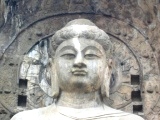Empress Wu Ze Tian
武则天
 Throughout the imperial history of China, there were many female regents who ruled on behalf of the reigning Emperor. Only one women step forward to proclaim herself a female emperor in her own right. Throughout the imperial history of China, there were many female regents who ruled on behalf of the reigning Emperor. Only one women step forward to proclaim herself a female emperor in her own right.
This woman was known to history as Wu Zhe Tian, 武则天, or Wu Zhao, 武曌, (625 - 705) who ruled China for almost half a century as empress, co ruler and later as the empress dowager of the Tang Dynasty. In 690, she finally proclaimed herself as Emperor of Zhou dynasty and ruled as a female emperor for 15 years before being forced to abdicate. She was the only woman in Chinese history to have founded a dynasty and to rule as an emperor.
She entered the Tang palace as a Cai Ren,才人, low ranking concubine of Li Shi Min (李世民) or Tang Tai Zong, the second emperor of the Tang Dynasty. When Emperor Tai Zong passed away in 649, she and other childless concubines became Buddhist nuns in accordance with Tang court practice.
The new Emperor Gao Zong ascended the throne and installed his wife, Wang, as Empress. Empress Wang viewed Consort Xiao, 萧淑妃, as her rival for the Emperor’s favor. Fearing for her position as she was childless and aware of Gao Zong’s attraction to Wu, Empress Wang recalled Wu from Gan Ye Si, 感业寺, where she reside as a nun.
Second return to the Tang Palace
Returning to the palace, Wu was made a consort of Gao Zong and given a rank of Zhaoyi, 昭义. Unknown to the empress, Wu was planning her political career at her expanse. In 654 after the birth of her second daughter, she was said to have strangled the newborn infant and accused Empress Wang for the murder. The following year, she accused Empress Wang and Consort Xiao of practicing witchcraft.
Emperor Gao Zong finally fell for the ruse and demoted Empress Wang and Consort Xiao. The two ladies were imprisoned and Wu finally become Gao Zong’s empress in 655. She soon appeared in court along with the emperor and participated in political decisions.
By 664, she and Gao Zong were officially referred to as Twin Rulers, 二圣. When Gao Zong died in 683, Wu became Empress Dowager and Regent.
The First and only Female Emperor of China
In 690, she was powerful enough to sack the reigning Tang Emperor and proclaim herself Emperor of the Zhou dynasty.
With a period of 15 years, she created 14 reign titles for herself. See Empress Wu's reign titles.
As a politician, Wu was ruthless against her rivals. When she discovered that Emperor Gaozong visited the imprisoned former Empress Wang and Consort Xiao, she ordered that both women be amputated and throw into wine vats till they die. She also established a secret police and her critics were brutally and often fatally tortured.
Even her own family members were not spared. When Wu learned that her grand children Li Chong Zhao, 李重照, and Li Xian Hui, 李仙蕙, criticized her sexual relationship with male lovers, she had both of them executed.
She also sought to use religious ideas to generate political capital. Aware that her plan to be a female emperor contradicted with Confucian ideas, she allowed her supporters to promote the Great Cloud Sutra (Mahamegha-sutra, 大云经). Drawing from the sutra, they alluded that the empress was the reincarnate of the Maitreya Buddha and hence suitable to be a female emperor.
On the other hand, she promoted based on meritocracy and sought to recruit men of talent to serve in her government even promoting family members of disgraced politicians. One famous example was Shang Guan Wan-er, 上官婉儿, who became a palace slave after the fall of her father. Empress Wu appreciated her talent and made her a trusted secretary.
During her reign, many new Chinese characters were invented to glorify her and the Vairocana Buddha sculpture in Longmen grotto, 龙门石窟, Luoyang was said to be modeled after her.
By 705, her critics managed to force her to abdicate and return political power to the Tang family. She became the empress dowager of Gao Zong again and in the same year, she passed away. Wu was buried as the Empress of Tang Gaozong in the Qian Lin Mausoleum.
Even in death, she defied traditions and is the only ruler to ask that her eulogy stele be left blank. It still stands today and is known as the Wordless Stele,无字碑.
Traditionally, Wu was criticized for usurping the Li family’s power and was demonized during the late Qing dynasty as part of a negative campaign against Empress Dowager Cixi and the Qing dynasty. However, after the death of Chairman Mao, Wu was praised by Madam Mao who was planning her own political ascension.
More than a thousand years after her death, her place in history continues to be debated and will continue to be.
References:
Charles Benn. (October 28, 2004) China's Golden Age: Everyday Life in the Tang Dynasty. Oxford University Press, USA
Gernet, Jacques. (2006). A history of Chinese civilization. UK: Cambridge : Cambridge University Press.
Kenneth Kuan Sheng Ch'en. (April 1, 1972)Buddhism in China. Princeton University Press
Related pages
|
